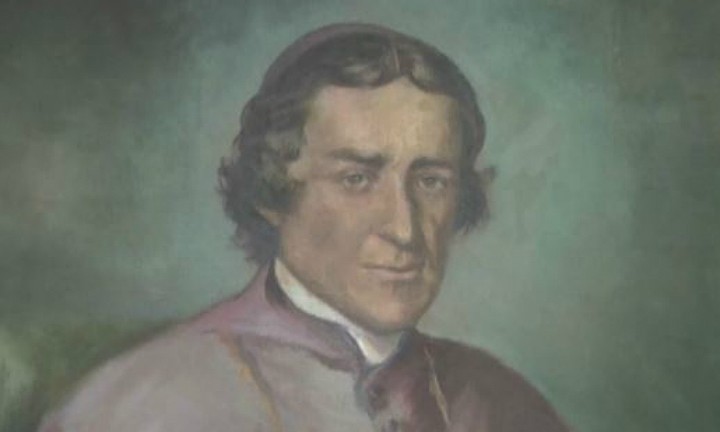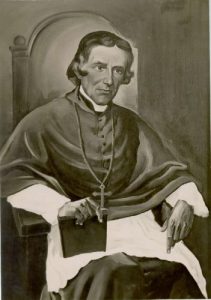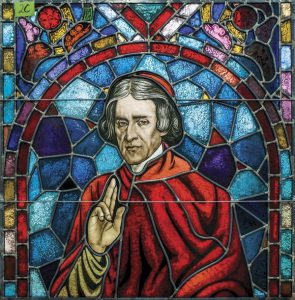
Venerable Frederic Baraga was a missionary priest, bishop, and pioneer. Frederic was born in 1797 to Johann and Maria Baraga. The family lived in a castle in the Austrian Dukedom of Carnolia, located in modern day Slovenia. Johann and Maria were devoted to their faith and committed to providing a good education for their children, but by the time Frederic turned sixteen, both of his parents had died. After his parent’s death, Frederic boarded with the family of a Catholic seminary professor. By the time he completed school, he knew French, German, Latin and Greek, in addition to his native Slovenian language. At nineteen, he went to Vienna to study law. He was physically fit and enjoyed long walks and excursions to visit other countries. At the University of Vienna, he came upon the writings of St. Alphonsus Liguori, and was inspired to become a priest. He relinquished his inheritance, entered the seminary at Laibach, and was ordained there two years later in 1823.
A call to the New World
Fr. Baraga’s first assignments were burdened with the influence of Jansenist heresy. Though the Austrian emperor banned such things, he established a Sacred Heart prayer sodality and wrote a Mass prayer book. He was disliked by his fellow priests, who mocked his efforts to teach the laity. He heard of an appeal from the Bishop of Cincinnati for clergy to come to the New World. Fr. Baraga wrote to him, and after obtaining release from his own bishop, set out and arrived at Cincinnati in 1831. There, he studied the Ottawa language and was sent to serve the Indians at Arbre Croche (now Cross Village, Michigan). He and his bishop found that the tribal chief had prepared the people for Baptism and Confirmation. The settlement was a peaceful place, and Fr. Baraga had little difficulty learning the customs of his people. He taught them devotions, established a small school, and wrote a prayer book and a catechism for his people in their own language. He lived in a small cabin, and the community’s church was also a simple log structure. He regularly ventured outward to visit other villages, and by the time he left the area after two and a half years, more than five hundred people had been baptized.
Expanding the mission territory
In 1833, Fr. Baraga left the community in the care of another priest. He visited Grand River (now Grand Rapids), where he baptized, catechized, and built a church and a school. He visited Detroit, where he had two thousand copies of his Ottawa prayer book printed. He visited Detroit Island on Green Bay where he also catechized, baptized, and left plans for the building of a church. In all of these places, he clashed with the French fur traders, who depended on the natives to trade their pelts for whiskey, and who encouraged their drunken ways from which Fr. Baraga sought to convert them.
One with his people
In 1835, the United States government sought to “redefine” the Indian Territory, forcing the natives to less desirable land. As a lawyer, Fr. Baraga defended their rights, but the government prevailed. He was sent by his bishop to minister to the Ojibway people at La Pointe, in northern Wisconsin. There, he became known as “the snowshoe Priest”, since that was the winter method he used to travel hundreds of miles during his eight years in the area. He taught them to support their hunting and fishing with the growing of crops. During a visit to Europe in 1836, he wrote a book on Indian life, which sparked much interest in the missions. He also had printed prayer books in the Ojibway language, and had an audience with Pope Pius IX. Upon his return to Wisconsin, he found the community flourishing, having built a larger church. He also ministered to the Ojibway to the east for fifteen years, in L’Anse, Michigan, where he also served European immigrants who came to work in the mines.

In 1853, a new diocese was created, which included the Upper Peninsula, part of the Lower Peninsula and part of northern Wisconsin. Fr. Baraga was named its first bishop. He finished a twenty year project, the publishing of a 1700 page Ojibway dictionary. From his many efforts to attract priests to the area, many came and the faith spread quickly. He spent twelve years in Sault Ste. Marie, Michigan, and in 1865, he moved the cathedral to the more centrally located Marquette. After several strokes, he died in Marquette January 19, 1868 at age seventy. He is buried in the crypt of St. Peter’s Cathedral in Marquette.

Bishop Baraga spent the last four decades of his life pouring all his efforts and energy for his people. He left behind a comfortable life in Europe to endure the hardships of brutal winters, deprivation, and spiritual isolation. He was a gentle and kind man who won countless souls for Christ’s kingdom, and he lived as his people did, from the land. He traveled thousands of miles to spread the Gospel via snowshoes, canoes, horseback, sleigh, and on foot. His life was the inspiration for later missionaries Sts. Clement Hofbauer and John Neumann. A master of eight languages, he wrote in several languages prayer books, a diary, a catechism, a devotional to the Virgin Mary, and numerous other writings. He is well remembered in northern Michigan, where a county, a town, and a shrine are all in his memory. His life of heroic virtue was finally recognized by Pope Benedict XVI in May of 2012, and the cause for his canonization is active.
